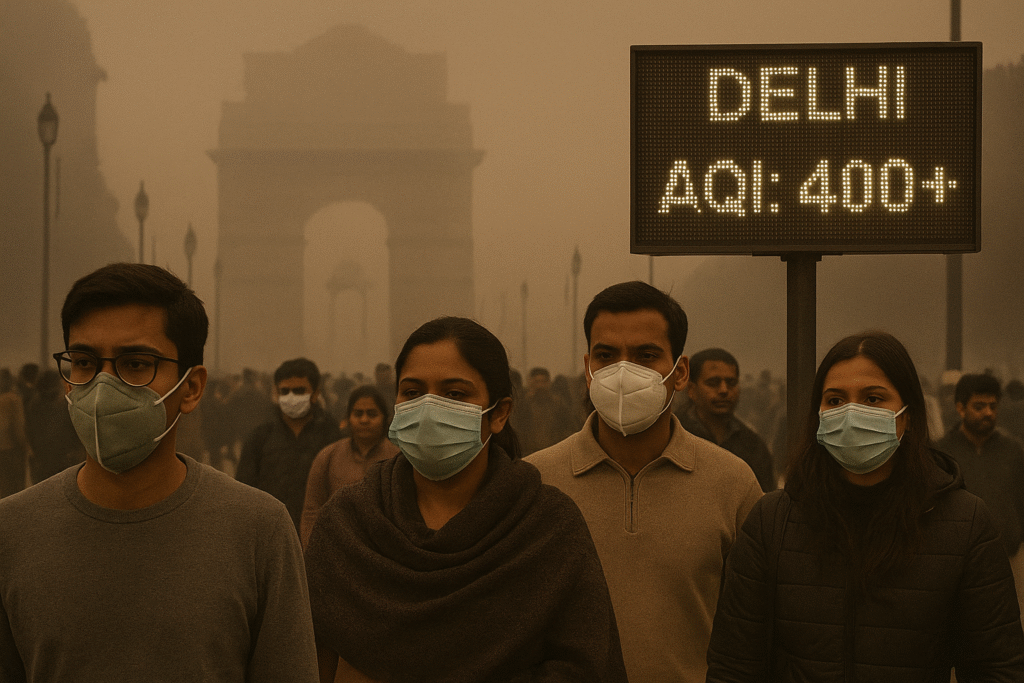A pioneering attempt to tame Delhi’s notoriously polluted air is underway: an aircraft has seeded clouds with the hope of triggering rainfall and washing away the haze. The move signals bold science-meets-policy in the fight against toxic air in India’s capital.
Why Cloud Seeding in Delhi?
The rising smog levels in New Delhi have become a seasonal crisis. Plunging temperatures trap vehicle emissions, construction dust and smoke from crop-burning, pushing the city’s Air Quality Index (AQI) into the “very poor” or “severe” category.
In this context, authorities have turned to weather-modification: a specially equipped aircraft dispersed hygroscopic agents into clouds over Delhi to stimulate rainfall.
The logic: induce rain, help wash airborne particulates (PM2.5/PM10) out of the atmosphere, and temporarily ease the crisis of toxic air.
The Data: What’s Being Done & What We Know
- The operation is being carried out in collaboration with Indian Institute of Technology Kanpur, using aircraft-borne seeding agents such as silver iodide and salt particles.
- Trials are planned when cloud cover and moisture meet required thresholds; success depends heavily on weather conditions.
- Officials expect artificial rainfall could occur within minutes to hours after seeding.
- The AQI in Delhi at the time of trial hovered around 300 (“very poor”) or worse.
- Scientists caution that while rain may reduce pollution temporarily, it does not address root causes, and the effect may be short-lived.
Effects on Health & Air Quality
The threat of polluted air in Delhi is not simply inconvenient — it’s a severe public-health hazard. The cloud-seeding experiment ties directly into health outcomes:
Respiratory stress & cardiovascular risk: High levels of PM2.5 and PM10 increase risks for asthma, bronchitis, and heart disease. Reducing particulates even for a short time can provide relief.
Short-term respite vs long-term exposure: If rainfall succeeds in clearing particulates, vulnerable groups (children, elderly, those with lung conditions) may see immediate benefit.
Mental & productivity relief: Cleaner air makes daily outdoor life more tolerable and may reduce stress caused by uncertainty and pollution alerts.
However: The transient nature of relief poses a caution. Unless emission sources are curbed, the polluted air will return once the rain ceases or if weather doesn’t cooperate.
Government Response & Policy Implications
The government of Delhi has green-lighted this novel step as part of its pollution-control strategy. Key points:
The trial had cabinet approval and involves multiple agencies for clearance, logistics and monitoring.
- Officials emphasise the scientific basis — but also note the operation can only proceed when meteorological conditions are favourable (cloud cover, moisture) — thus timing is critical.
- Critically, this is complementary to other pollution control measures (vehicle restrictions, construction bans, anti-smog techniques), not a substitute. Experts repeatedly stress this is not a solution on its own.
- For policymakers, the test raises broader questions: if effective, should such cloud-seeding become routine? What are long-term impacts, costs, and environmental implications?
Causes of Pollution & Why Cloud Seeding Might Help
To understand the motive behind the cloud-seeding push, one must understand the pollution causes:
Crop-burning in neighbouring states sends massive plumes into north-west India, which then settle into Delhi’s air basin.
Vehicle/industrial emissions combine with cold weather inversion layers in winter, trapping pollutants close to the ground.
Construction dust, biomass burning and fireworks further amplify particulate loads.
Given that many causes are external or structural, inducing rainfall is seen as a mitigative strategy: a way to reduce pollutant load when generation continues unabated.
Challenges & What to Watch
The technique’s success depends on cloud conditions (moisture, depth) which may be absent in peak-pollution winters.
The long-term environmental and health impacts of the seeding agents (e.g., silver iodide) are not fully understood.
Rain may clean air temporarily, but without cutting emissions, pollution will return — potentially frustrating residents and undermining trust.
Monitoring and data transparency will be key: How much did PM2.5 drop? How long did improvement last? What area and duration are impacted?
Cost, scalability and repeatability must be assessed before it becomes a regular tool rather than a one-off headline.
- Delhi’s aircraft-based cloud-seeding initiative is bold, newsworthy and offers a sign of serious action against the capital’s toxic air. But it is only one part of the puzzle. For residents, awareness is vital: heed air-quality alerts, use protective masks, limit outdoor activities on “very poor” days. For policymakers and citizens alike: demand transparency in results, push for lasting emissions cuts, not just reactive fixes.
Clean air is a right, and community engagement, policy accountability and scientific clarity must go together. Share this story, stay informed, and press for change — because artificial rain alone cannot clear the air unless we also stop polluting it.





